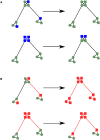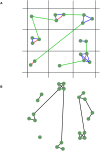Staged Models for Interdisciplinary Research
- PMID: 27362836
- PMCID: PMC4928782
- DOI: 10.1371/journal.pone.0157261
Staged Models for Interdisciplinary Research
Erratum in
-
Correction: Staged Models for Interdisciplinary Research.PLoS One. 2016 Aug 25;11(8):e0162151. doi: 10.1371/journal.pone.0162151. eCollection 2016. PLoS One. 2016. PMID: 27560144 Free PMC article.
Abstract
Modellers of complex biological or social systems are often faced with an invidious choice: to use simple models with few mechanisms that can be fully analysed, or to construct complicated models that include all the features which are thought relevant. The former ensures rigour, the latter relevance. We discuss a method that combines these two approaches, beginning with a complex model and then modelling the complicated model with simpler models. The resulting "chain" of models ensures some rigour and relevance. We illustrate this process on a complex model of voting intentions, constructing a reduced model which agrees well with the predictions of the full model. Experiments with variations of the simpler model yield additional insights which are hidden by the complexity of the full model. This approach facilitated collaboration between social scientists and physicists-the complex model was specified based on the social science literature, and the simpler model constrained to agree (in core aspects) with the complicated model.
Conflict of interest statement
Figures








References
-
- Hempeî CG. Aspects of Scientific Explanation. New York: Free Press, New York; 1965.
-
- Feyerabend P. Against method. London: Verso, London; 1993.
-
- Chwif L, Paul RJ, Barretto MRP. Discrete event simulation model reduction: A causal approach. Simul Model Pract Th. 2006;14(7):930–944. 10.1016/j.simpat.2006.05.001 - DOI
-
- Innis G, Rexstad E. Simulation model simplification techniques. Simulation. 1983;41(1):7–15. 10.1177/003754978304100101 - DOI
MeSH terms
LinkOut - more resources
Full Text Sources
Other Literature Sources

